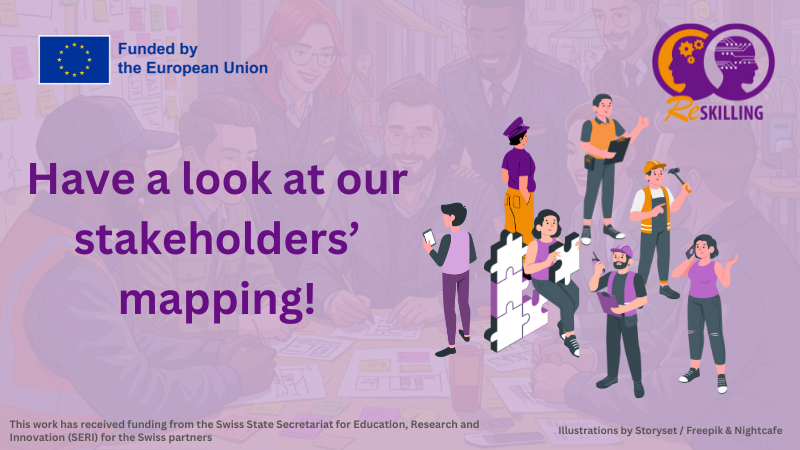ReSKILLING stakeholder map: a key step and a never ending story!

Stakeholders have a fundamental role in any innovation. They are needed to ensure new concepts, services, and tools serve common purposes and support the transition to more sustainable, inclusive, and efficient systems. But what are exactly stakeholders and how to ensure they play their role?
Stakeholders in the context of the RESKILLING project
RESKILLING investigates ways forward to ensure workers and businesses are equipped to thrive within the deployment of Connected, Cooperative and Automated Mobility (CCAM) solutions. The project develops a framework to support territories and affected parties in adapting to the associated socio-economic transformations. This framework includes analyses of CCAM impacts across the entire value chain, design of pathways for skill development, and building an ecosystem that can actively drive and co-create the future of mobility. This ecosystem is actually also an enabling factor for the analysis and the pathways’ design.
Considering the planned work and outcomes of the project, stakeholders are both a target audience for the RESKILLING outcomes, and a necessary component of the work process. They are understood in the project as individuals, groups, organisations or institutions that can affect, be affected by, or be involved in the development and implementation of CCAM-related strategies for employment, skills and workforce transformation, as well as those contributing to innovation and growth of mobility for people and goods.
In contexts where policy, technology and employment intersect, such as in CCAM, traditional top-down or expert-led approaches may not be sufficient to capture all institutional realities or local constraints. Stakeholder engagement provides an alternative approach by offering a collaborative space for problem definition, decision-making and foresight. In this way, affected actors are empowered to influence outcomes from within the process, and better benefit from them.
Who is affected and how to ensure their contribution
A first step to ensure stakeholders play their role in the RESKILLING project is to identify who they are and how to reach out to them. A stakeholder mapping work was conducted in the first months of the project, starting from 3 main topics: CCAM, Jobs, and Skills. Seven main categories were defined in connection with all 3 topics: transport operators, industry, workers, end-users, authorities, researchers and educators, and funders and insurers. These categories were discussed and reviewed among all consortium members, to ensure a coverage as exhaustive as possible, and clarify the understanding related to each category.
The result of that work came out as a stakeholder map in a design platform. You can click here to have access to it!
However, everyday activity of RESKILLING partners constantly brings new inspiration and perspectives, as well as awareness of additional related organisations. Discussions on the actors affected or influencing CCAM and its consequences in terms of jobs and skills are on going in the consortium. They led to new versions of the stakeholder map, which was reedited after 2 and 3 months. This is a very rich process, which is necessary to ensure the quality of the future work conducted in the project. But a solid and stable structure is a condition to a successful involvement. Therefore, the project map was translated into a table including expected contributions from each category, relevance of the project for them, and planned involvement. Another table was prepared to follow the engagement of each individual stakeholder, to guarantee a good representation of all categories identified, and to monitor the quality of the engagement work, so that stakeholders really do play their expected role.
This process is still in the run, and will require adaptation in the course of project activities. This is the whole challenge of adapting sustainable work to a constantly evolving socio-economic context. Existing classifications and studies are very instrumental in identifying most affected and enabling stakeholders, but every initiative has its own topic and demands a suited frame. The RESKILLING stakeholder map and engagement strategy prepared in the first six months of the project will certainly follow that rule!